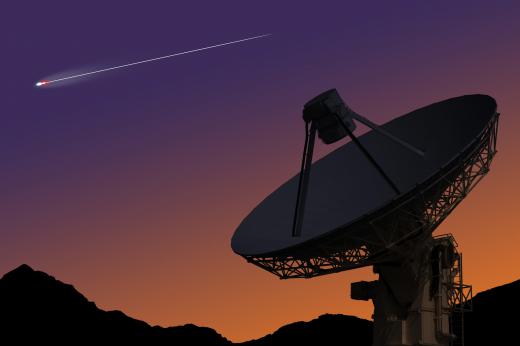What are Radio Waves?
 Michael Anissimov
Michael Anissimov
Radio waves are an invisible form of electromagnetic radiation (EMR) that varies in wavelength from around 0.04 inches (one millimeter) to over 62,000 miles (100,000 km), making it one of the widest ranges in the electromagnetic spectrum. "Radio" is a catch-all term describing all forms of EMR with a wavelength longer than 0.04 inches (one millimeter) and a frequency below 300 GHz. It is generated by the movement of electric charge, which can result from an electric current or from the random motion of atoms and molecules. This form of EMR is crucial to human communications, and is used for television, radio and mobile phones, as well as in radar and astronomy.
How Radio Waves are Produced

All electromagnetic radiation can be regarded as waves that undulate through an electromagnetic field, like ripples in a pond. They are produced when an electrically charged particle, usually an electron, changes its speed or direction of motion. This can happen in a number of ways, such as heating of atoms and molecules, and changes in the energy levels of electrons; the waves generated by radio transmitters result from the flow of electric current. The frequency and wavelength depend on the amount of energy involved, with higher frequencies and shorter wavelengths indicating higher energies. If the energy change is relatively small, radio waves may be produced.
Uses

The best-known use of radio waves is to send images, audio, and text in the form of signals — radio's long wavelength allows it to circumvent obstacles and travel long distances, unlike visible light and other higher frequency radiation. Radio waves with a wavelength of less than around 10 meters are absorbed by the atmosphere. Longer waves bounce back and forth between the ionosphere and the ground, making radio ideal for transmitting over the horizon. The lowest frequencies are used for communication with submarines, due to their low energy — for stealth — and high penetrating power. These lower frequencies can be considered to have more "bass," meaning they penetrate further, especially through thick media such as water.

To send information by radio waves, it has to be coded in some way. There are two main methods, known as amplitude modulation (AM), and frequency modulation (FM). In AM, information is encoded by varying the amplitude, or height, of the waves, while the FM method involves using changes the frequency to carry data. The patterns of different amplitudes or frequencies are decoded where they are received to reproduce the original information, which may be images, sounds or text. In this way, complex information can be transmitted over long distances cheaply.

Radio astronomy is a vital tool for understanding the universe. Due to the existence of clouds of gas and dust in galaxies, there is a limit to the amount of information that can be obtained using visible light or higher frequencies of EMR. Radio waves, however, can pass through these obstacles, and much of what has been learned about the interiors of galaxies has come through the analysis of natural radio sources. Astronomers have also been able to detect the radiation from the big bang itself, which, due to the expansion of the universe, has been stretched out from its initial very high frequencies into the microwave range — this is known as the cosmic background radiation (CMB).
Health Effects

Concerns have been raised about the possible effects on health of exposure to radio waves, particularly those in the microwave range, used by mobile phones and radar. When radio frequency radiation is absorbed by tissue, it can cause heating. Normal exposure is not thought to cause any problems, but being in close proximity to a powerful radar transmitter can be potentially dangerous. The lens of the eye is particularly susceptible to damage by heating, and excessive exposure to microwave radiation could potentially lead to cataracts. There is also concern about the long-term effects of frequent mobile phone use, but as of 2013, clinical studies have been inconclusive.
History
Radio waves were first predicted in 1865 by James Clerk Maxwell, who came up with the equations for electromagnetism, later known as Maxwell's equations. While working on the relationship between electromagnetism and light, he realized that other forms of electromagnetic radiation, with wavelengths above and below the visible range, were possible. The existence of the lower wavelength radiation was demonstrated experimentally 22 years later, in 1887, when Heinrich Hertz generated radio waves in his lab. Within a few decades, they were widely used for transmitting information. Guglielmo Marconi and Nikola Tesla are both credited with being early pioneers in the area of radio, but Marconi patented the first wireless telegraphy system in 1896.
AS FEATURED ON:
AS FEATURED ON:















Discussion Comments
@craneman: Ground the tower to the earth so when you touch the steel it doesn't go through your body, it goes through the grounding system.
Perhaps attach a 1ot cable from the tower to the crane basket before you grab the steel.
i work in construction. my job is around AM transmission towers. i have to touch steel being lifted by a crane. i am getting shocked. what can i do?
i agree with anon28169. how do people know they are getting radio waves?
@ Balbalaas- For the reasons mentioned, there might be a grain of truth to what some say about radio waves penetrating the brain. I am not sure if a foil cap will protect them, but radio waves have the potential to cause behavior and mental ability changes in people.
The theory goes that a radio wave that is set at a frequency that matches a person’s brainwave frequency (1 to 20 hertz) may have unknown and adverse affects on their brain. I am not sure this would make someone hear voices, but it could cause disorientation or temporary deterioration of mental capacity.
Luckily, frequencies this low are not present in everyday life, being reserved mostly for military research. The lowest frequency commonly found is around 60 Hz used in electricity transmission.
@ Anon28169- Radio waves can be detected by antennas. If you are referring to the effect of radio waves on humans, it depends on their intensity and frequency.
High intensity, low frequency radio waves can shock people if they get too close. Ultra low frequency radio waves like those found in power lines can even kill and ignite flammable fumes.
Higher frequency, high intensity radio waves will create heat much like a microwave. These can be dangerous to the body, especially the eye tissue. Prolonged exposure to high frequency radio waves causes the body's cells to resonate making the body heat up. In the eye, this has the effect of cooking the lens, causing cataracts.
How do humans detect radio waves?
Post your comments